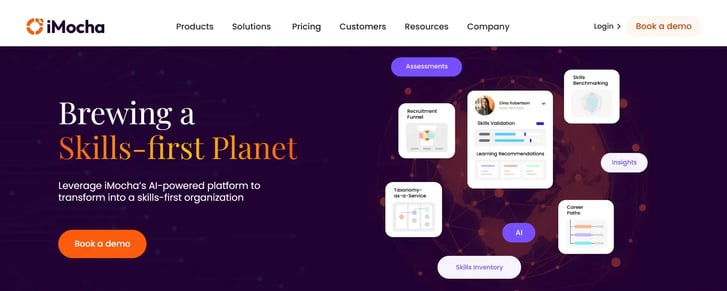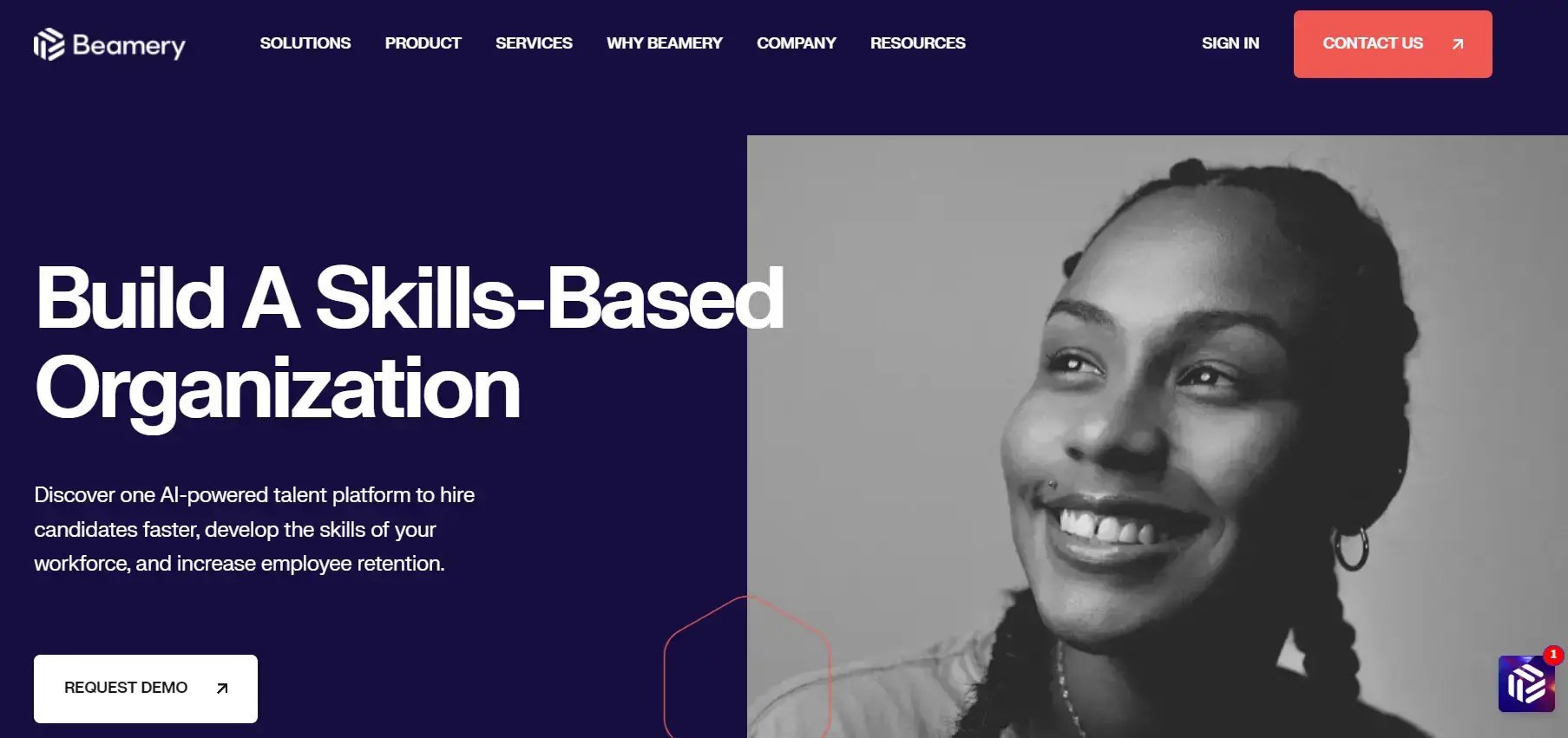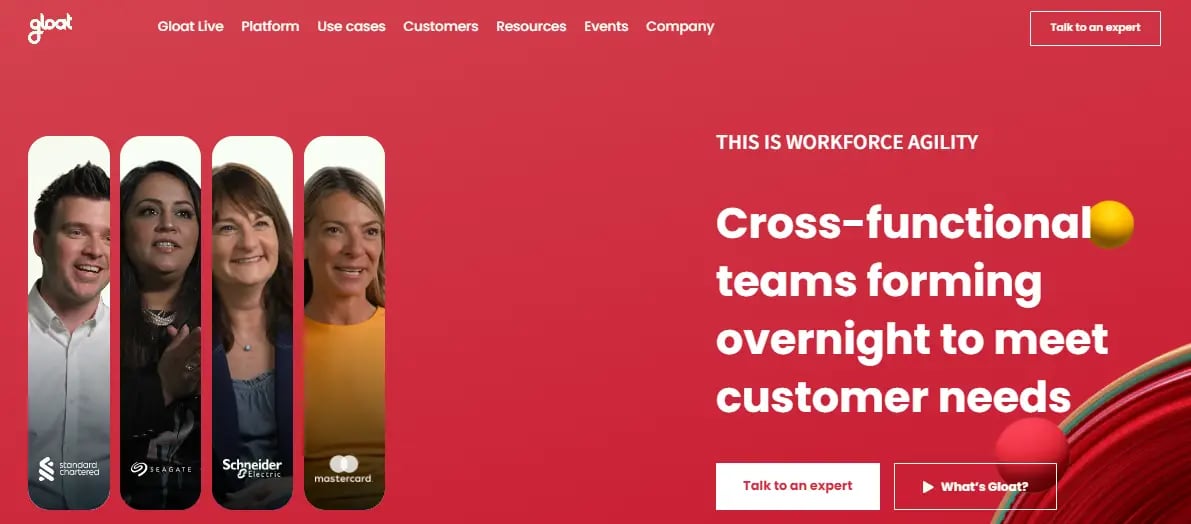Do you know almost 35% of employees prefer quitting their jobs because they have not been looked after properly?
Keeping this in mind, workforce management is one of the crucial aspects of running a business. In the current competitive scenario, businesses need a gamut of things to keep their employees content. One such tool that does a good job is the Talent Management Suite. It manages and optimizes the complete life cycle of talent, from recruiting and onboarding to performance management and succession planning.
Talent management platforms use skills analytics to show insights for recognizing skill gaps and aligning employee competencies with business strategy. This evidence-based method, in turn, enhances workforce productivity. This post highlights the top 10 talent management suites that excel in skills analytics, along with other key features.
|
Table of contents |
Top 10 Talent Management Suites to Consider in 2025
1. iMocha
 iMocha is one of the best talent management suites. Built as a AI-powered skills intelligence platform, it offers solutions to improve varying aspects of talent development and management. Through advanced tools and data, it helps organizations draw out insights to manage their workforce effectively. This, therefore, helps companies move toward a skills-based approach to talent management.
iMocha is one of the best talent management suites. Built as a AI-powered skills intelligence platform, it offers solutions to improve varying aspects of talent development and management. Through advanced tools and data, it helps organizations draw out insights to manage their workforce effectively. This, therefore, helps companies move toward a skills-based approach to talent management.
Some of its key features include:
- AI Skills Match: The AI-powered feature of iMocha aligns job descriptions with candidate skills for efficient hiring. Making hiring fair breeds the talent's proper screening via rich libraries of assessments and an ideal candidate profile, increasing hiring accuracy and efficiency.
- Skills Assessment: The platform offers a rich library of skills assessments to make intelligent decisions about every employee's skills and benchmarks. It goes to great lengths to find the areas where further development is needed and leads to the appropriate growth strategy.
- Skills Taxonomy: iMocha has a very advanced skills taxonomy which maps and categorizes core job competencies or essential skills related to several jobs. Talent development with clearly defined skill requirements and targeted training is supported.
- Detailed Skill Gaps Analysis: It enables the user to identify critical skill gaps in their workforce and train them with focused development programs, hence bridging the gaps and improving the performance of the employees generally.
G2 Rating: 4.4/5 (262 reviews)
|
Not sure how to figure out the skills gap in your company? Book a demo with iMocha to understand it better. |
2. Darwinbox
 The Darwinbox provides end-to-end functionality for acquiring, developing, and retaining the best talents. It enables HRs and business leaders to drive evidence-based decisions across a growth-oriented culture and effective employee engagement through seamless integrations. Its key features include:
The Darwinbox provides end-to-end functionality for acquiring, developing, and retaining the best talents. It enables HRs and business leaders to drive evidence-based decisions across a growth-oriented culture and effective employee engagement through seamless integrations. Its key features include:
- Configurable Talent Processes: Highly configurable modules help configure everything, from appraisals to succession planning so that the suite can handle every unique organizational philosophy and objective.
- AI-Driven People Analytics: Darwinbox houses high-impact people analytics that integrates AI-driven distributed data down to easy-to-understand dashboards. Hence, HR teams can uncover trends, predict risks, and make better talent decisions faster.
- Continuous Performance Management: It enables feedback and constant performance tracking along with 360-degree feedback mechanisms, thereby facilitating goal alignment of employees with organizational objectives.
G2 Rating: 4.3/5 (137 reviews)
3. Workday
 Workday helps organizations handle talent right from onboarding to performance and succession planning. It provides complete visibility into employees' skills and career development, with AI-driven insights that enable better talent decisions. Workday has an integrated platform for streamlining workforce development and improving employee engagement. Its key features include:
Workday helps organizations handle talent right from onboarding to performance and succession planning. It provides complete visibility into employees' skills and career development, with AI-driven insights that enable better talent decisions. Workday has an integrated platform for streamlining workforce development and improving employee engagement. Its key features include:
- Succession and Career Planning: With the help of advanced succession planning tools, the platform helps discover high-potential employees and prepares them for the future.
- AI-driven Talent Insights: To help organizations make better decisions, it provides detailed insights on the current skillset of their employees, performance trends, and more.
- Continuous Talent Development: This module allows employees to manage their development through personalized learning opportunities, feedback loops, and goal-setting in one interface.
G2 Rating: 4.0/5 (1,327 reviews)
4. Oracle Talent Management
Oracle's talent management solution is a comprehensive platform that helps manage the entire talent lifecycle. It allows companies to attract, develop, and retain top performers. Its feature-rich offering is valuable in employee engagement. Not just that, it also boosts productivity and simplifies career development. Its key features include:
- AI-Driven Skills Engine: It continuously identifies and tracks organizational skills to provide managers and HR teams with informed recruitment, development, and succession planning decisions using real-time, automated insights.
- Continuous Performance Management: This allows for immediate feedback and frequent check-ins to help align employee development and growth better with the objectives of the business.
- Succession Planning and Leadership Pipeline: Through dynamic dashboards and analytics, succession planning identifies high potentials and builds up a leadership pipeline that reduces risks and grows top talent for long-term leadership within the organization.
G2 Rating: 3.4/5 (384 review)
|
Does your company lack data-driven insights? Find out how iMocha's skills intelligence feature can help! |
5. ADP
 ADP offers an integrated solution that ties employee development, recruitment, and performance management into one system. It further helps businesses to deal with every step in the employee lifecycle, from hiring to career growth. This platform leverages data-driven insights to optimize performance, enhance team engagement, and reduce HR processes. Its key features include:
ADP offers an integrated solution that ties employee development, recruitment, and performance management into one system. It further helps businesses to deal with every step in the employee lifecycle, from hiring to career growth. This platform leverages data-driven insights to optimize performance, enhance team engagement, and reduce HR processes. Its key features include:
- Comprehensive Compensation Management: ADP provides real-time market data, allowing companies to create competitive compensation packages and reward top performers appropriately. It also manages complex structures with tools to ensure pay equity and fairness.
- Integrated Performance and Development Tools: It aligns individual, team, and business objectives through customized coaching sessions and performance metrics.
- Data-Driven Succession Planning: By using predictive analytics, it spots high-potential employees. By providing insights into strengths, ADP helps companies create future-ready leadership pipelines.
G2 Rating: 4.1/5 (3,460 reviews)
6. Eightfold.ai
 Eightfold.ai is an AI-native talent intelligence platform designed to optimize the entire talent lifecycle—from talent acquisition and internal mobility to skill development and workforce planning. It's known for its deep-learning-based talent matching and career pathing.
Eightfold.ai is an AI-native talent intelligence platform designed to optimize the entire talent lifecycle—from talent acquisition and internal mobility to skill development and workforce planning. It's known for its deep-learning-based talent matching and career pathing.
Some of its key features include:
- Talent Intelligence Engine: Uses deep learning to match candidates to roles based on skills, potential, and career trajectory—not just resumes.
- Internal Mobility & Career Planning: Encourages upskilling and talent retention by recommending roles based on employee skills and goals.
- Diversity Hiring Insights: Provides analytics that help mitigate bias and improve DEI hiring metrics through AI-driven recommendations.
- Skills Inventory & Gap Analysis: Offers enterprise-wide visibility into current workforce capabilities and skill gaps.
G2 Rating: 4.2/5 (200 reviews)
7. Cornerstone OnDemand
 Cornerstone OnDemand is a comprehensive talent management solution built around learning and development, performance management, and internal mobility. It’s particularly strong in LXP (Learning Experience Platform) and skills-based talent planning.
Cornerstone OnDemand is a comprehensive talent management solution built around learning and development, performance management, and internal mobility. It’s particularly strong in LXP (Learning Experience Platform) and skills-based talent planning.
Some of its key features include:
- AI-Powered Skills Graph: Understands and maps employee skills, suggests learning paths, and guides career growth.
- Performance & Goal Tracking: Enables regular check-ins, 360-degree feedback, and dynamic performance reviews.
- Learning Experience Platform (LXP): Personalized learning content for upskilling, compliance, and career development.
- Succession Planning: Identifies high-potential employees and maps leadership pipelines to future business needs.
G2 Rating: 4.3/5 (9 reviews)
8. Fuel50
 Fuel50 is a next-gen talent marketplace and career pathing solution focused on internal mobility, reskilling, and employee engagement. It’s ideal for enterprises aiming to reduce attrition and build a future-ready workforce.
Fuel50 is a next-gen talent marketplace and career pathing solution focused on internal mobility, reskilling, and employee engagement. It’s ideal for enterprises aiming to reduce attrition and build a future-ready workforce.
Some of its key features include:
- Internal Talent Marketplace: Matches employees to internal gigs, roles, mentors, and learning based on their skills and aspirations.
- Career Pathing Engine: Enables transparent growth maps and personalized development planning.
- Skill Development & Readiness: Assesses workforce capabilities and recommends targeted upskilling.
- Workforce Agility Metrics: Provides visibility into how adaptable and future-ready your talent pool is.
G2 Rating: 4.3/5 (19 reviews)
9. Beamery
 Beamery is a talent lifecycle management platform designed for enterprise hiring and internal mobility. It combines CRM-style engagement with skills intelligence to build long-term workforce strategies.
Beamery is a talent lifecycle management platform designed for enterprise hiring and internal mobility. It combines CRM-style engagement with skills intelligence to build long-term workforce strategies.
Some of its key features include:
- Talent CRM & Pipelines: Nurtures talent pools, automates outreach, and maintains candidate relationships over time.
- AI-Driven Career Navigation: Supports internal mobility and retention by mapping skill paths and job opportunities for employees.
- Skills Taxonomy & Insights: Gives deep visibility into organizational skills to inform talent planning and development.
- Compliance & DEI Tracking: Includes compliance-ready data flows and bias-reduction features to improve fair hiring practices.
G2 Rating: 4.1/5 (158 reviews)
10. Gloat
 Gloat is an AI-powered talent marketplace that connects employees to new projects, learning opportunities, and roles within their current organization. It’s designed to increase internal mobility and optimize workforce agility.
Gloat is an AI-powered talent marketplace that connects employees to new projects, learning opportunities, and roles within their current organization. It’s designed to increase internal mobility and optimize workforce agility.
Some of its key features include:
- Internal Talent Marketplace: Matches employees to stretch assignments, gigs, mentorships, and full-time roles based on real-time skill data.
- Workforce Agility Dashboard: Offers insights into talent readiness, role demand, and capability distribution.
- AI Career Pathing: Helps employees explore future roles and the skills they need to acquire to get there.
- Project-Based Learning Opportunities: Facilitates hands-on learning experiences by connecting talent with short-term internal gigs.
G2 Rating: 4.4/5 (34 reviews)
| Check out talent management best practices to maximize the potential of your talent management software |
Conclusion
When looking for leading talent management solution, most possess fantastic performance and succession management tools. However, iMocha is an outstanding option for its high-class skill intelligence solution. Beyond the usual talent management processes, it performs accurate skills evaluation and extensive skills benchmarking and offers in-depth skills analytics.
iMocha allows enterprises to build a future-ready and agile workforce with its high-scale skills taxonomy and upskilling recommendations. It aligns talent with constantly changing business needs, enabling companies to meet present needs and adequately prepare for the future.
FAQs
What is a talent management suite?
An integrated solution that offers tools for recruitment, employee development, performance management, and succession planning. Thus, it enables organizations to manage talent through each point in the employee lifecycle.
What key features should a talent management suite have?
Key features include performance management, succession planning, learning and development, competency tracking, AI-driven analytics, and employee engagement tools that ensure everything keeps growing in tune with the business goals.
Which metrics should be tracked with the talent management suite?
Metrics like engagement level, turnover rate, skills gaps, and employee performance must be tracked to ensure succession readiness for optimized alignment and workforce optimization with organizational objectives.

